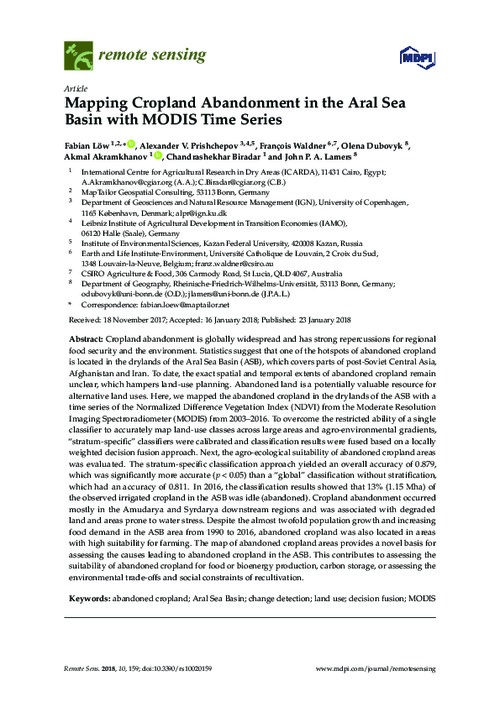Resource information
Cropland abandonment is globally widespread and has strong repercussions for regional
food security and the environment. Statistics suggest that one of the hotspots of abandoned cropland
is located in the drylands of the Aral Sea Basin (ASB), which covers parts of post-Soviet Central Asia,
Afghanistan and Iran. To date, the exact spatial and temporal extents of abandoned cropland remain
unclear, which hampers land-use planning. Abandoned land is a potentially valuable resource for
alternative land uses. Here, we mapped the abandoned cropland in the drylands of the ASB with a
time series of the Normalized Difference Vegetation Index (NDVI) from the Moderate Resolution
Imaging Spectroradiometer (MODIS) from 2003–2016. To overcome the restricted ability of a single
classifier to accurately map land-use classes across large areas and agro-environmental gradients,
“stratum-specific” classifiers were calibrated and classification results were fused based on a locally
weighted decision fusion approach. Next, the agro-ecological suitability of abandoned cropland areas
was evaluated. The stratum-specific classification approach yielded an overall accuracy of 0.879,
which was significantly more accurate (p < 0.05) than a “global” classification without stratification,
which had an accuracy of 0.811. In 2016, the classification results showed that 13% (1.15 Mha) of
the observed irrigated cropland in the ASB was idle (abandoned). Cropland abandonment occurred
mostly in the Amudarya and Syrdarya downstream regions and was associated with degraded
land and areas prone to water stress. Despite the almost twofold population growth and increasing
food demand in the ASB area from 1990 to 2016, abandoned cropland was also located in areas
with high suitability for farming. The map of abandoned cropland areas provides a novel basis for
assessing the causes leading to abandoned cropland in the ASB. This contributes to assessing the
suitability of abandoned cropland for food or bioenergy production, carbon storage, or assessing the
environmental trade-offs and social constraints of recultivation.


